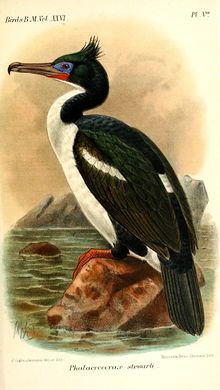
Editor,
Malcolm Baker,
Baker Publishing,
44 Spencer Avenue,
Maketu 3189,
NEW ZEALAND.
In psychology and ethology, imprinting is any kind of phase-sensitive learning (learning occurring at a particular age or a particular life stage) that is rapid and apparently independent of the consequences of behavior. It was first used to describe situations in which an animal or person learns the characteristics of some stimulus, which is therefore said to be "imprinted" onto the subject. Imprinting is hypothesized to have a critical period.

BirdLife International (2012). "Phalacrocorax chalconotus". IUCN Red List of Threatened Species. Version 2013.2. International Union for Conservation of Nature. Retrieved 26 November 2013.

The species is dimorphic in appearance. Roughly half the individuals are mostly dark bronze, but with white patches, similar to the King Shag; the remainder are bronze all over. The two morphs breed together indifferently. These large, chunky birds are 68 cm (27 in) and weigh 1.8-2.9 kg (4-6.4 lbs).
Bronze Shags breed colonially, making raised cup nests out of organic material and guano. Colonies are large enough to be strikingly visible, and are used year after year; there is a notable one on the northern shore of Taiaroa Head at the mouth of Otago Harbour. They feed in coastal waters, rarely if ever being seen inland or far out to sea.
They are related to the other blue-eyed shags.
Genomic imprinting is an epigenetic phenomenon by which certain genes can be expressed in a parent-of-origin-specific manner. It may also ensure transposable elements remain epigenetically silenced throughout gametogenic reprogramming to maintain genome integrity.[1] It is an inheritance process independent of the classical Mendelian inheritance. In Homo sapiens, imprinted alleles are silenced such that the genes are either expressed only from the non-imprinted allele inherited from the mother (e.g. H19 or CDKN1C), or in other instances from the non-imprinted allele inherited from the father (e.g. IGF-2). However, in plants parental genomic imprinting can refer to gene expression both solely or primarily from either parent's allele.[2] Forms of genomic imprinting have been demonstrated in fungi, plants and animals.[3]
Genomic imprinting is an epigenetic process that can involve DNA methylation and histone modulation in order to achieve monoallelic gene expression without altering the genetic sequence. These epigenetic marks are established in the germline and can be maintained through mitotic divisions.
Appropriate expression of imprinted genes is important for normal development, with numerous genetic diseases associated with imprinting defects including Beckwith–Wiedemann syndrome, Silver–Russell syndrome, Angelman syndrome and Prader–Willi syndrome[citation needed].